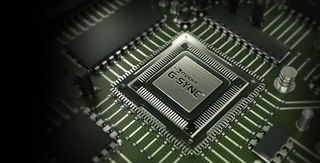Nvidia says G-Sync Ultimate was 'never defined by nits alone' after dropping 1000+ nits HDR requirement (Updated)
Nvidia G-Sync Ultimate gaming monitors no longer require HDR 1000 certification.

Update: Nvidia has offered the following response to reports of the G-Sync Ultimate specification change:
Late last year we updated G-SYNC ULTIMATE to include new display technologies such as OLED and edge-lit LCDs.
All G-SYNC Ultimate displays are powered by advanced NVIDIA G-SYNC processors to deliver a fantastic gaming experience including lifelike HDR, stunning contract, cinematic colour and ultra-low latency gameplay. While the original G-SYNC Ultimate displays were 1000 nits with FALD, the newest displays, like OLED, deliver infinite contrast with only 600-700 nits, and advanced multi-zone edge-lit displays offer remarkable contrast with 600-700 nits. G-SYNC Ultimate was never defined by nits alone nor did it require a VESA DisplayHDR1000 certification. Regular G-SYNC displays are also powered by NVIDIA G-SYNC processors as well.
The ACER X34 S monitor was erroneously listed as G-SYNC ULTIMATE on the NVIDIA web site. It should be listed as “G-SYNC” and the web page is being corrected.
Nvidia certainly isn't backing down on this case.
But while G-Sync Ultimate may not have been defined exclusively by nits alone, it was certainly one of the most heavily marketed benefits to customers since its introduction in 2019, even if it was technically bereft of a requirement for VESA's DisplayHDR 1000 certification.
The Nvidia website clearly stated 'over 1000-nits brightness' as the unique selling point for G-Sync Ultimate until the end of 2020—even going as far as a table that defines 'Best HDR 1000 nits' as the sole differentiator between G-Sync grades.
The biggest gaming news, reviews and hardware deals
Keep up to date with the most important stories and the best deals, as picked by the PC Gamer team.


Original story: Nvidia has quietly downgraded HDR requirements for its top G-Sync Ultimate specification. Twitter user PCMonitors spotted a subtle recent change in the text on Nvidia’s website which effectively downgrades the requirements for the top G-Sync Ultimate definition from VESA DisplayHDR 1000 to merely ‘lifelike HDR’.
It’s the latest tweak to a broader G-Sync platform that has become a little messy, complicated and possibly a bit broken, at least in terms of how it is marketed.
Previously, the most advanced G-Sync Ultimate specification required VESA DisplayHDR 1000 certification with ‘over’ 1000 nits of brightness performance. That can be confirmed using the Wayback Machine website, which logs historical versions of many web pages.
However, the current definition of G-Sync Ultimate on Nvidia’s website mentions only an entirely unspecific requirement for ‘lifelike HDR’. The question then follows - what really separates a top-tier G-Sync Ultimate monitor for the middle tier plain-old G-Sync monitor?
Look at the difference between this page (https://t.co/xbQ0rQDuQn) now vs. all the way back in... November 2020. Subtle removal of reference to 'Best HDR 1000 nits' and changed to 'Lifelife HDR' - without telling anybody. pic.twitter.com/mayHvebhfQJanuary 17, 2021
Unfortunately, Nvidia’s own marketing material is thoroughly ambiguous. It stipulates that the Ultimate tier requires the ‘top NVIDIA G-SYNC processors’ referring to the G-Sync modules or boards that used to be required for all G-Sync monitors. Meanwhile, the bottom G-Sync Compatible tier is denoted as not using Nvidia processors. But there’s no mention of modules one way or the other for the middle 'G-Sync' tier.

Best CPU for gaming: the top chips from Intel and AMD
Best graphics card: your perfect pixel-pusher awaits
Best SSD for gaming: get into the game ahead of the rest
We’re hoping for clarification from Nvidia on the subject (update: see above statement), but for now our hunch is that only the top Ultimate tier has a hard requirement for the G-Sync module. Consequently, the earlier HDR 1000 requirement meant an otherwise expensive and highly-specified monitor including the module but not supporting HDR 1000 wouldn’t qualify for the G-Sync Ultimate tag, leaving such a screen struggling to differentiate itself from other middle-tier G-Sync panels that lack the module.
One such monitor is the Alienware 38 Curved AW3821DW gaming monitor, which is rated to 600 nits and comes with the G-Sync Ultimate tag—something not previously possible with the initial Ultimate specification.
Whatever, the G-Sync definitions are certainly both in flux and lacking in clarity. Arguably, rolling HDR into G-Sync is proving to be something of a misstep.
Nvidia may have decided to wind back on the HDR requirement, enabling G-Sync Ultimate the creation of monitors with the module but not HDR 1000, the latter being a pretty onerous requirement if what you mainly want to do is offer the best refresh and frame syncing performance.
We’ve reached out to Nvidia for clarification, so watch this space.

Jeremy has been writing about technology and PCs since the 90nm Netburst era (Google it!) and enjoys nothing more than a serious dissertation on the finer points of monitor input lag and overshoot followed by a forensic examination of advanced lithography. Or maybe he just likes machines that go “ping!” He also has a thing for tennis and cars.
Most Popular






